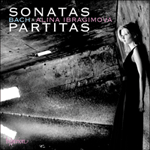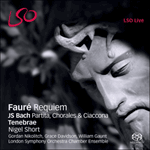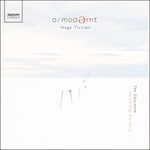The Partita No 2 in D minor (BWV1004) is the best known of Bach’s six works for unaccompanied violin on account of its brilliantly sustained, imaginatively varied and architecturally magnificent Ciaccona. Like the B minor Partita, it begins with an Allemanda which on first acquaintance may seem a little lacking in geniality. This movement, along with the Corrente which follows it and the subsequent Giga, progresses in a single continuous melodic line, in which harmony provided by multiple stopping is almost entirely absent. The Sarabanda, by contrast, with its richly chordal passages gives the impression, to some extent illusory, of greater complexity. The mighty concluding Ciaccona, a 257-bar ‘morceau célèbre’ and veritable Goliath of the violin repertory, is built on a noble and declamatory theme upon which Bach develops sixty-four continuous variations, exploring a dazzlingly intricate range of harmonic possibilities. This is a movement of unfathomable subtlety, astounding virtuosity and great expressive and architectural beauty. Bach seems to have set himself incalculable challenges, sustaining his Chaconne with a major-key section, rhythmic diversity and a kaleidoscope of technical devices both pushing the boundaries of, and summarizing, we might say, the baroque violinist’s art.
from notes by Nicholas Anderson © 2009
La Partita no 2 en ré mineur (BWV1004) est la plus célèbre des six œuvres pour violon seul de Bach. Elle doit à sa Ciaccona brillamment soutenue, pleine d’une imagination diversifiée et magnifiquement construite. Comme la Partita en si mineur, elle commence par une Allemanda qui, à première vue, peut sembler manquer un peu de douceur. Ce mouvement, tout comme la Corrente qui le suit et la Giga subséquente, progresse en une ligne mélodique unique et continue, pratiquement dépourvue de l’harmonie provenant de l’emploi des cordes multiples. En revanche, la Sarabanda, avec ses passages richement harmoniques, donne l’impression, illusoire dans une certaine mesure, d’une grande complexité. La puissante Ciaccona conclusive, un «morceau célèbre» de deux cent cinquante-sept mesures, véritable Goliath du répertoire du violon, est construite sur un noble thème déclamatoire que Bach développe en soixante-quatre variations qui s’enchaînent, explorant une gamme audacieusement complexe de possibilités harmoniques. C’est un mouvement d’une subtilité insondable, d’une virtuosité incroyable et d’une grande beauté expressive et architecturale. Bach semble s’être donné à lui-même des défis impossibles à estimer, soutenant sa chaconne avec une section dans une tonalité majeure, une diversité rythmique et un kaléidoscope de procédés techniques qui repoussent à la fois les limites de l’art du violoniste baroque et, pourrait-on dire, le résument.
extrait des notes rédigées par Nicholas Anderson © 2009
Français: Marie-Stella Pâris
Die Partita Nr. 2 in d-Moll (BWV 1004) ist das berühmteste der sechs Bach’schen Werke für Violine solo, da hier die brillant kontinuierliche, phantasievoll variierte und architektonisch großartige Ciaccona vorkommt. Ebenso wie die h-Moll Partita beginnt auch dieses Werk mit einer Allemanda, die auf den ersten Blick vielleicht nicht übermäßig genial wirkt. Dieser Satz und die beiden folgenden, Corrente und Giga, fährt mit einer einzelnen, durchgehenden Melodielinie fort, in der ein harmonisches Gerüst mit Doppelgriffen praktisch abwesend ist. Die Sarabanda hingegen gibt mit ihren üppigen akkordischen Passagen den—teilweise illusorischen—Eindruck größerer Komplexität. Die mächtige abschließende Ciaccona, ein 257-taktiges „morceau célèbre“ und wahrhaftiger Goliath des Violinrepertoires, ist auf einem noblen und deklamatorischen Thema aufgebaut, worüber Bach 64 fortlaufende Variationen komponiert und dabei eine schillernd komplexe Palette harmonischer Merkmale präsentiert. Es ist dies ein Satz von unergründlicher Subtilität, außerordentlicher Virtuosität und einer besonderen ausdruckvollen und architektonischen Schönheit. Bach scheint sich hier unermessliche Ziele gesteckt zu haben: die Chaconne wird mit einer Dur-Passage aufrechterhalten, die rhythmische Vielfältigkeit und ein Kaleidoskop von technischen Stilmitteln dehnen einerseits, wenn man so will, die Grenzen des Barockgeigers aus und fassen sie andererseits auch wieder zusammen.
aus dem Begleittext von Nicholas Anderson © 2009
Deutsch: Viola Scheffel


 Bach: Sonatas and Partitas for solo violin
Bach: Sonatas and Partitas for solo violin Fauré: Requiem; Bach: Partita, Chorales & Ciaccona
Fauré: Requiem; Bach: Partita, Chorales & Ciaccona From the ground up – The chaconne
From the ground up – The chaconne
